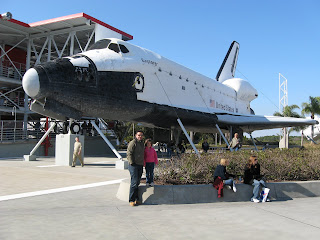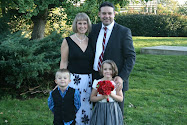 We took the road East out of Orlando to the Kennedy Space Centre for a day of memorable experiences. After purchasing our tickets we got onto one of the buses to take a tour around the facility. This included the Apollo/Saturn V Centre and the LC-39 Observation Gantry which is 60 foot tall, where we managed to see the latest Space Shuttle on its launch pad being prepared for an April departure. We also passed the launch control centre and the track that the crawler-transporter takes which carries the shuttle to the launch pad. It takes the crawler approx 7-8 hrs to move the shuttle the 3 1/2 miles from the Vehicle Assembly Building to the launch site.
We took the road East out of Orlando to the Kennedy Space Centre for a day of memorable experiences. After purchasing our tickets we got onto one of the buses to take a tour around the facility. This included the Apollo/Saturn V Centre and the LC-39 Observation Gantry which is 60 foot tall, where we managed to see the latest Space Shuttle on its launch pad being prepared for an April departure. We also passed the launch control centre and the track that the crawler-transporter takes which carries the shuttle to the launch pad. It takes the crawler approx 7-8 hrs to move the shuttle the 3 1/2 miles from the Vehicle Assembly Building to the launch site.
We stopped off at the Apollo/SaturnV centre and stood underneath a Saturn V space rocket which has been broken down into 3 parts so that you could see the various stages and respective engines. Hanging from the ceiling alongside Saturn V are large copies of each of the mission badges. Roy, one of the engineers who worked for NASA for 30 years, was in the centre happily answering any questions, so we went to say hello. Fact - it wasn't until Apollo 11 that America finally landed on the moon and there were only 7 missions that actually made it to the moon. Fact No2 - Apollo 11, the first successful mission to the moon, very nearly never made it back. Buzz Aldrin used a Bic Pen lid to act as a circuit breaker which was essential for the lunar module to take off from the moons surface. Without that pen he and his illustrious counterparts would have been stranded on the moon.
 On our bus tour around NASA we were amazed by the amount of wildlife that we saw including an abundance of armadillos, a bald eagle and I spotted an alligator swimming up a small inlet of river. Merritt Island National Wildlife Refuge surrounds most of the space centre, with NASA owning 2/3 of the park. On our return to the Space Station Centre we wondered around all the exhibits including the rocket garden, several rockets that you could look inside, then Chris and I went on the new Shuttle Launch Simulator Facility ride.
On our bus tour around NASA we were amazed by the amount of wildlife that we saw including an abundance of armadillos, a bald eagle and I spotted an alligator swimming up a small inlet of river. Merritt Island National Wildlife Refuge surrounds most of the space centre, with NASA owning 2/3 of the park. On our return to the Space Station Centre we wondered around all the exhibits including the rocket garden, several rockets that you could look inside, then Chris and I went on the new Shuttle Launch Simulator Facility ride.Fewer than 550 men and women of the earth's almost 7 billion people have ever flown in space and we got to meet one of them - Jack Lousma. He flew on 2 missions, Skylab II where he was the pilot, and STS-3 where he was Columbia's commander. We chatted briefly and he even said thanks to Chris for 'serving' and doing his bit; I think he was quite touched!

The other amazing experience that we had today was to actually watch NASA launching its newest weather satellite. The unmanned rocket blasted off from Cape Canaveral carrying a $500 million GOES satellite. The launch was scheduled to take place at 6.15pm which we didn't think we would see as we expected to have left by then. However, having been told the launch would be delayed we left the centre and drove down the causeway where we saw lots of cars parked on the verge so decided to join them on the off chance it would take off soon. Luckily, after approximately 20 minutes the launch took place in twilight - quite amazing. It is not everyday you get to meet someone who has actually been into space and watch a rocket launch. A difficult day to beat.


















No comments:
Post a Comment